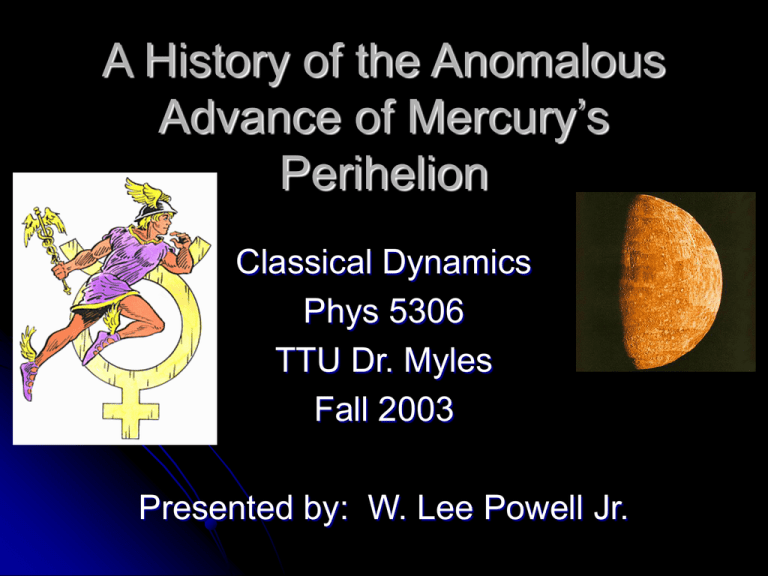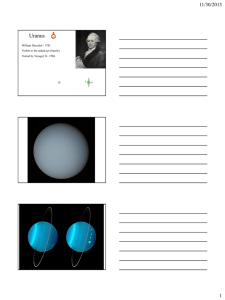A History of the Anomalous Advance of Mercury’s Perihelion Classical Dynamics
advertisement

A History of the Anomalous Advance of Mercury’s Perihelion Classical Dynamics Phys 5306 TTU Dr. Myles Fall 2003 Presented by: W. Lee Powell Jr. Titius-Bode Law a = 0.4 + 0.3 x 2n where a is the semimajor axis in (AU) and the exponent, n, takes values minus infinity, 1,2,3, ... Planet Mercury Venus Earth Mars Asteroid belt Jupiter Saturn Uranus n minus infinity 0 1 2 3 4 5 6 Predicted 0.4 0.7 1 1.6 2.8 5.2 10 19.6 Accepted 0.387 0.723 1 1.524 ~2.8 5.204 9.582 19.201 Titius-Bode Law The first test of the law occurred a few years later (1781) when William Herschel discovered Uranus --- at the distance predicted by the relationship. Independent Discovery of Neptune After the discovery of Uranus, it was noticed that its orbit was not as it should be in accordance with Newton's laws. It was therefore predicted that another more distant planet must be perturbing Uranus' orbit. Neptune was first observed by Galle and d'Arrest on 1846 Sept 23 very near to the locations independently predicted by Adams and Le Verrier from calculations based on the observed positions of Jupiter, Saturn and Uranus. Independent Discovery of Neptune An international dispute arose between the English and French (though not, apparently between Adams and Le Verrier personally) over priority and the right to name the new planet; they are now jointly credited with Neptune's discovery. Subsequent observations have shown that the orbits calculated by Adams and Le Verrier diverge from Neptune's actual orbit fairly quickly. Had the search for the planet taken place a few years earlier or later it would not have been found anywhere near the predicted location. More than two centuries earlier, in 1613, Galileo observed Neptune when it happened to be very near Jupiter, but he thought it was just a star. On two successive nights he actually noticed that it moved slightly with respect to another nearby star. But on the subsequent nights it was out of his field of view. Had he seen it on the previous few nights Neptune's motion would have been obvious to him. But, alas, cloudy skies prevented observations on those few critical days. Urbain Jean Joseph Le Verrier b. 1811 d. 1877 Urbain Jean Joseph Le Verrier Urbain Le Verrier was appointed to teach astronomy at the École Polytechnique in 1837 and abandoned his first subject of chemistry. He worked at the Paris Observatory for most of his life where his drive for efficiency was to made him very unpopular. A contemporary said of him: I do not know whether M. Le Verrier is actually the most detestable man in France, but I am quite certain that he is the most detested. Independent Discovery of Neptune Le Verrier was a co-predictor of the existence and position of Neptune, along with J.C. Adams. Le Verrier was better served by the German astronomer Galle (who found the planet in one hour) than Adams was by Airy who gave the task to Challis, the director of the Cambridge Observatory. He observed the planet first but did not recognize it. Urbain Jean Joseph Le Verrier Le Verrier calculated the position of Neptune from irregularities in Uranus's orbit. As one of his colleagues said:... he discovered a star with the tip of his pen, without any instruments other than the strength of his calculations alone. Urbain Jean Joseph Le Verrier Arago, the director of the Paris observatory who had first suggested that Le Verrier work on this problem, said In the eyes of all impartial men, this discovery will remain one of the most magnificent triumphs of theoretical astronomy, one of the glories of the Académie and one of the most beautiful distinctions of our country. Le Verrier received many honours and widespread recognition for this achievement. The London Times carried the headline on the 1 October 1846:Le Verrier's planet found. He was awarded the Copley Medal of the Royal Society of London and, in France, became an officer in the Legion of Honour. Urbain Jean Joseph Le Verrier In 1854 Le Verrier became director of the Paris Observatory but his unpopularity, mentioned above, led to him being removed from the post in 1870. A successor was appointed but died in 1873. At this time Le Verrier again was given the post but his authority was severely restricted as he was supervised by a council. He held the post until his death. Urbain Jean Joseph Le Verrier Soon after arriving at the Paris Observatory, Arago also suggested that Le Verrier work on trying to obtain a solution for the orbit of Mercury. This project occupied Le Verrier for much of his life. Mercury: A Difficult Observing Target Nearest planet to the Sun. Never more than 28 degrees away from the Sun. Legend says that Copernicus lamented that he had never seen Mercury himself. Mercury From Earth Alignments of Mercury Mercury Transits Transits provide very accurate measurements of orbital parameters. Don’t occur at every inferior conjunction: so relatively rare (something like 7 years apart). Example: Last three occurred in 1986, 1993, and 1999. Mercury at Transit Le Verrier’s Results Produced the first theory of Mercury’s orbit in 1843. Not perfect, since it was based mostly on older observations. Reworked theory using most recent and accurate observations, resulting in a revised theory, published in 1859, including the discovery of an anomalous advance in the perihelion: the cause of the discrepancy between prediction and observation. Mercury’s Perihelion Advance Anomalous Perihelion Advance Why wasn’t it discovered previously? Its size! To be clear: “Anomalous” refers not to the fact that there is an advance, but to the size of it: it differed from what Newtonian mechanics predicted based on the known planetary bodies. Anomalous Perihelion Advance Planetary perturbations result in a predicted advance of a little more than 500” per century. Mercury makes about four orbits a year, so this amounts to around 1 ¼” per orbit. 260,000 years for a complete precession. Anomalous Perihelion Advance Theoretical predictions by Le Verrier, due to planetary bodies in arcseconds/century: Venus: 280”.6 Earth: 83”.6 Observed Mars: 2”.6 amount: Jupiter: 152”.6 39”/century Saturn: 7”.2 greater!! Uranus: 0”.1 TOTAL: 526”.7 Possible Causes? Le Verrier’s proposed solutions: Two possibilities: 1) Errors in the estimated masses of the planets, particularly Venus. 2) An as yet undiscovered planet: Vulcan! Vulcan The name Vulcan had been put forth by Babinet, a French astronomer with a habit for this type of thing. If more than one were discovered: the Cyclopes! Around the same time predicted Hyperion, outside of Neptune’s orbit, to explain the differences between Le Verrier’s predicted value, and the actual orbit observed. Vulcan Le Verrier proposed either a single planet, several small planets, or even a disk of material. Numerous false identifications, no definitive discovery. Very robust assertion! Simon Newcomb 1882: American astronomer Newcomb verified Le Verrier’s theory of the motion of Mercury. 1895: Produced detailed work on the orbits of Mercury, Venus, Earth, and Mars, which became the basis for the tables of these planets’ motions in the main national ephemeris. Simon Newcomb His solution: An alteration of Newton’s law of gravitation. The change made the tables very accurate, but was abandoned within just a few years. Hugo von Seeliger Director of the Munich observatory from 1882 to 1924. Next big theory to be accepted: matter surrounding the Sun, similar to Le Verrier’s suggestion. He supported the theory with observations of the zodiacal light. The zodiacal light appears at dusk or dawn near the horizon where the Sun just set or will rise: now accepted to be due to small particles near the Sun scattering light. Velocity-dependent Force Laws Wilhelm Weber, Gauss, Riemann, Clausius, Ritz, Maxwell… Finally, Einstein General Relativity: 1915. Einstein used Le Verrier’s anomalous advance of Mercury as a prime application of his theory: it gave the correct answer! Einstein Albert Einstein published his General Theory of Relativity, which explained the deviations in the motions of Mercury without the need to invoke an unknown intra-Mercurial planet. In May 1929 Erwin Freundlich, Potsdam, photographed the total solar eclipse in Sumatra, and later carefully examined the plates which showed a profusion of star images. Comparison plates were taken six months later. No unknown object brighter than 9th magnitude was found near the Sun. But… Mercury often played a central role in arguments against relativity, late into the twentieth century. Many of the earlier proposed solutions are still being considered from time to time! Conclusions The anomalous advance of Mercury’s perihelion is an interesting historical case. For my references, see the written counterpart to this presentation.



